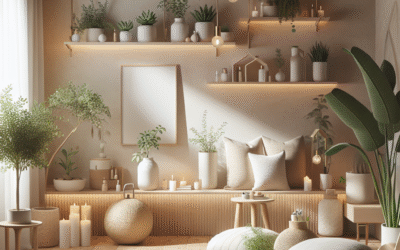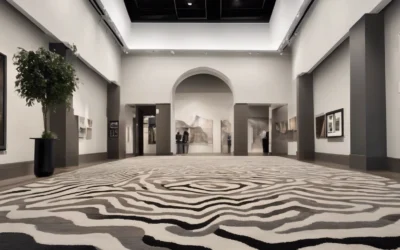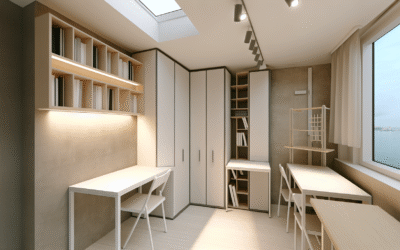
From Cluttered to Calm: Design Secrets for a Productive Home Office
Quick definition: From Cluttered to Calm: Design Secrets for a Productive Home Office is a practical approach to reorganizing physical space, lighting, sound, and workflow so you can get more done with less stress.
Hook: Why a messy desk steals hours and how to get them back
Ever sit down ready to work and search for a pen, a charger or—worst of all—motivation? The gap between intention and action often begins with physical clutter. In this guide, From Cluttered to Calm: Design Secrets for a Productive Home Office, you’ll find focused, usable design tactics that restore calm and fuel productivity.
In the first 100 words: From Cluttered to Calm: Design Secrets for a Productive Home Office explains how layout, storage, lighting, and routine combine to create a workspace that supports deep focus. You’ll learn clear steps, quick wins, and longer-term investments that pay back time and mental energy.
What you’ll achieve by reading this article:
- A step-by-step plan to move from chaos to a calm, efficient home office.
- Design principles that reduce distractions and speed decision-making.
- Tools, product suggestions, and checklists you can apply in one weekend.
Roadmap: This guide covers space planning and zoning, storage and decluttering tactics, ergonomics and lighting, sound and privacy, a practical weekend overhaul, case studies showing measurable gains, recommended tools, and a compact FAQ section ready for voice search.
1. Space Planning: Create Zones That Work With How You Actually Work
Why zoning matters for focus
Designing a home office like a studio apartment in miniature helps your brain know what to do in each spot. Staging a work zone, a reference zone, and a reset zone reduces decision fatigue. This is a core pillar of From Cluttered to Calm: Design Secrets for a Productive Home Office.
How to map your workflow: a simple exercise
Take a 10-minute audit: list your daily tasks, note equipment you use, and mark whether tasks need isolation, collaboration, or quick reference. Then sketch a floor plan and assign a zone to each task type. Keep zones within 2 to 8 feet of each other when possible.
Design patterns that support zones
- Focus area: minimal visual clutter, single monitor or laptop, task lighting.
- Reference area: shelves or vertical file storage for manuals, binders, and quick-glance items.
- Reset area: a small coffee/comfort corner or standing nook for short breaks.
Quick implementation steps
- Sketch a 10-minute floor plan. Label three zones.
- Place the desk so that your back is to the least-used entrance; facing the door can add stress for some people.
- Reserve adjacent wall space for a whiteboard or pinboard dedicated to current priorities.
Actionable takeaway: Finish the 10-minute audit and move one item from your desk to another zone. Small steps anchor bigger changes.
2. Decluttering & Storage: Simple Systems That Stick
Decluttering as a ritual, not a marathon
Decluttering loses momentum when it’s framed as a single event. Instead, adopt a weekly 15-minute reset. This recurring habit aligns with the guidance in From Cluttered to Calm: Design Secrets for a Productive Home Office and keeps visual noise low.
Three storage strategies that actually work
Choose one primary storage method per item type—paper, tech, supplies—and be consistent.
- Paper: Scan and recycle. Keep a one-in/one-out rule for physical documents.
- Tech: Docking stations and cable channels make devices feel intentional, not accidental.
- Supplies: Transparent bins or labeled drawers reduce “where did I put that?” searches.
Comparison: Storage choices at a glance
| Storage Type | Pros | Cons | Best For |
|---|---|---|---|
| Closed Cabinets | Hides clutter, cleaner look | Can become a “dump” spot | High visual clutter areas |
| Open Shelving | Quick access, decorative | Shows mess; needs styling | Books, display items |
| Clear Bins / Labels | Fast identification | Requires labeling discipline | Supplies, small electronics |
Practical steps for a weekend overhaul
- Empty your desktop. Toss or recycle visible trash.
- Create three piles: Keep (daily), Store (seldom), Toss/Donate.
- Choose storage solutions for the Store pile and set a reminder to review them in 90 days.
Actionable takeaway: Buy two labeled bins this week—one for “Active” and one for “Archive”—and place them within arm’s reach.
3. Ergonomics & Lighting: Small Changes, Big Gains
Ergonomics basics that reduce fatigue
Adjust chair height so feet rest flat and your knees are at a 90-degree angle. Screen top should be at or slightly below eye level. A simple external keyboard and mouse gives flexibility with laptop placement.
Lighting that supports focus and mood
Natural light helps. Place your desk perpendicular to a window to reduce glare. Add layered lighting: ambient for the room, task light for work, and accent light for atmosphere.
Checklist: Ergonomic setup in 10 minutes
- Raise laptop on stand. Add external keyboard.
- Use a monitor arm to position screen at eye level.
- Place a desk lamp with 3000–4000K for task lighting.
- Consider a footrest if your feet can’t reach the floor comfortably.
Tools & product picks
- Chair: try models with lumbar support (example: Herman Miller Aeron as premium reference).
- Monitor arm: gas-spring arms for easy adjustability.
- Lighting: LED desk lamps with dimmer and color temperature control.
- Apps: Screen dimmers and blue-light schedulers for evening work.
Actionable takeaway: Adjust your primary screen height today. Even a stack of books can make a measurable difference.
4. Sound, Privacy & Behavioral Design for Deep Work
Why sound design matters
Noise interrupts focus more than we think. Background chatter, appliance noises, and notifications fragment attention. From Cluttered to Calm: Design Secrets for a Productive Home Office includes practical sound and privacy tactics that restore longer focus blocks.
Soundproofing and masking solutions
- Soft furnishings: rugs and curtains absorb mid- and high-frequencies.
- Acoustic panels: target reflections on hard walls for clearer audio during calls.
- White noise or sound-masking: apps or machines smooth unpredictable spikes.
Behavioral cues that reduce interruptions
Use visual signals for family or roommates: a simple door sign, a matching light, or noise-canceling headphones as “do not disturb” flags. Schedule “office hours” to concentrate on deep tasks and share them openly.
Quick routines to protect focus
- Turn off non-essential notifications during focus blocks.
- Block 90-minute sessions on your calendar labeled “Deep Work.”
- Use a short pre-work ritual—5 minutes of planning—to prime attention.
Actionable takeaway: Set a single visible signal for “Do not interrupt” and use it for two weeks to establish a habit.
5. Digital Declutter & Workflow: Clearing Mental Bandwidth
Digital clutter drains cognitive capacity
Piles of open tabs, an overflowing desktop, and unmanaged email are invisible clutter. This is as much a part of From Cluttered to Calm: Design Secrets for a Productive Home Office as physical storage.
Quick digital triage
- Inbox: apply a two-folder rule—Action and Reference.
- Desktop: limit to one or two active files; archive the rest.
- Browser tabs: use a tab manager (e.g., OneTab or browser groups) and close anything inactive for 48 hours.
Workflow systems that reduce decision load
Adopt a single task manager. Systems like Notion, Todoist, or Trello centralize tasks so your brain can stop tracking them. Use recurring templates for frequent work: meeting notes, design briefs, and weekly reviews.
Recommendations and honest assessments
- Notion — flexible database-driven pages, steep learning curve but powerful for long-term organization.
- Trello — visual boards for project stages, great for one-off projects or teams.
- Todoist — lightweight, fast, and strong recurring task support.
Actionable takeaway: Pick one tool and migrate your top 10 tasks into it this week. Keep the rest elsewhere until you decide to consolidate.
6. Weekend Overhaul: A Practical How-To
Before you start: set a 4-hour limit
Time-box the overhaul to avoid decision paralysis. A focused session yields visible change and creates momentum for ongoing maintenance.
Step-by-step 4-hour plan
- Hour 1 — Clear the surface: remove everything from your desk and floor surface.
- Hour 2 — Sort and decide: Keep, Store, Toss/Donate. Be decisive: if you haven’t used it in 6 months, move it out.
- Hour 3 — Zone and place: Return items to zones and set up storage (drawers, bins, shelves).
- Hour 4 — Light, sound, finish: adjust lighting, add a plant or sensory cue, and run a 30-minute test work session.
Checklist: Items to buy (starter list)
- Label maker or preprinted labels
- Two clear bins for Active/Archive
- Monitor riser or laptop stand
- LED task lamp with dimmer
- Cable clips or a cable tray
Actionable takeaway: Schedule your 4-hour overhaul and invite one friend or partner to help. Two people finish faster and stay motivated.
7. Case Studies & Measurable Results
Case study A: Freelance designer — from distraction to billable hours
Sarah, a freelance graphic designer, spent mornings searching for reference materials and reorganizing mid-day. She used the From Cluttered to Calm: Design Secrets for a Productive Home Office plan over two weekends: zoning, a digital cleanup, and a weekly 15-minute reset. Within four weeks she reported a 20% increase in billable hours and a 40% drop in time spent locating files.
Case study B: Small remote team — clearer handoffs, fewer meetings
A three-person marketing team applied simple storage standards and shared a single Notion project board. The team reduced status meetings from three weekly to one and reclaimed 3 hours per person per week for deep work. The team lead credits visible project boards and a shared “Reference Zone” for faster handoffs.
What these cases teach us
- Small physical changes compound with small process changes.
- Consistency beats perfection: weekly resets maintain gains.
- Mental clarity often follows visible order; the inverse is also true.
Actionable takeaway: Pick one metric to measure (time spent finding things, billable hours, or number of interruptions) and track it for a month.
8. Tools, Resources & Visual Content to Support Your Makeover
Recommended software and hardware
- Notion — central workspace and templates.
- Trello — simple visual project boards.
- Forest or Focus@Will — concentration aids.
- Herman Miller or Steelcase chairs (test before buying) — ergonomic investment.
- Bose or Sony noise-canceling headphones — effective for open-plan homes.
Infographic and image suggestions
Ideal visuals to accompany this guide:
- Before/after photo pair of a desk makeover (wide shot + detail close-ups).
- Zone layout diagram showing Focus, Reference, and Reset areas with distances and recommended furnishings.
- Checklist graphic for the 4-hour weekend overhaul.
- Comparison chart of storage types (as above) styled for social sharing.
Alt-text suggestions for images
- Alt: “Before and after home office desk showing cluttered surface and clean, zoned workspace.”
- Alt: “Floor plan diagram with labeled zones: Focus, Reference, Reset for a small home office.”
- Alt: “Stacked clear bins labeled Active and Archive beside a laptop on a raised stand.”
Actionable takeaway: Create or commission one infographic this month. Visuals accelerate adoption and make the change easier to share with others.
9. The Research Backing the Design Choices
Key evidence and sources:
- Harvard Business Review — research on attention and multitasking supports single-task zones and reducing interruptions.
- American Psychological Association — studies linking clutter with increased stress and decreased productivity.
These sources support small, repeated changes—zoning, decluttering, and limiting task-switching—as effective ways to restore focus and reduce stress.
Frequently Asked Questions
How long does it take to see benefits from From Cluttered to Calm: Design Secrets for a Productive Home Office?
Most people notice small benefits within 48–72 hours after decluttering and adjusting ergonomics. Bigger gains—like reduced interruptions and more billable hours—typically appear within two to four weeks as habits form.
What is the easiest first step I can take this evening?
Clear your desktop and put five nonessential items into a box labeled “Maybe.” Close unnecessary browser tabs and move your primary screen to eye level. These small actions reduce decision friction tomorrow morning.
Can I apply these design secrets in a shared space or small apartment?
Yes. Use vertical storage, foldable desks, and clear signage to create micro-zones. Portable partitions or a bookshelf can create a modest visual barrier that signals “work mode.”
Which tools help with digital declutter recommended in this guide?
Notion, Trello, and Todoist are good starting points. For tab management, try OneTab or browser tab groups. For email, use filters and a two-folder Action/Reference workflow.
How do I keep family or roommates from interrupting me?
Set visible signals for focus time, share a calendar of “office hours,” and negotiate three core rules: predictable availability, a single communication channel for urgent issues, and quiet windows for deep work.
Do these design changes require big purchases?
No. Many high-impact steps are low-cost: decluttering, a laptop stand (or books), a lamp, and labeled bins. Invest in ergonomic gear only after identifying persistent pain points.
Conclusion: Your plan to go From Cluttered to Calm: Design Secrets for a Productive Home Office
From Cluttered to Calm: Design Secrets for a Productive Home Office shows that thoughtful choices—about layout, storage, lighting, and routines—deliver outsized gains. Start small: plan zones, clear surfaces, and set one weekly reset. Add ergonomic and sound improvements gradually. Track one metric, like interruptions or billable hours, and measure progress after 30 days.
Next steps:
- Complete the 10-minute zone audit this afternoon.
- Schedule a 4-hour weekend overhaul within the next two weeks.
- Pick one tool (Notion, Trello, or Todoist) to centralize tasks.
If you want tailored advice, try the “Start Here” checklist in the related links above for step-by-step templates and printable labels.
Final reminder: keep the change simple, repeat the rituals, and design your space for how you work—not how you imagine you should.
Content Disclaimer
Information in this article is provided for educational purposes only. Results may vary based on individual circumstances and physical spaces. Consult relevant professionals (ergonomists, health providers, or licensed contractors) for personalized advice.
Categories
- Accent Walls & Ceilings (61)
- Art Curation & Gallery (62)
- Bedding Style Trends (68)
- Bedroom Makeover (81)
- Bohemian & Eclectic Styles (58)
- DIY & Budget-Friendly Decor (64)
- Eco-Friendly Design (62)
- Furniture Care (71)
- Home Decor & Design Ideas (162)
- Home Wellness Spaces (59)
- Integrated Outdoor Living (67)
- Japandi Style (61)
- Kids and Nursery Decor (59)
- Living Room Decor (79)
- Mix & Match Techniques (73)
- Modern & Contemporary Design (66)
- Rug Sizing & Placement (73)
- Scandinavian Design Inspiration (20)
- Seasonal Home Decor (79)
- Small Space Solutions (73)
- Wall Art & Painting Tips (77)
Recent Comments
Archives
Product Gallery
-
Large Area Green Rugs for Bedroom Nordic Living Room Decoration Shaped Carpet Irregular Plush Lounge Rug Home Thick Washable Mat
Rated 5.00 out of 5$36.00 – $225.00Price range: $36.00 through $225.00 -
Nordic Style Rugs for Bedroom Morandi Living Room Decoration Carpet Large Area Geometry Lounge Rug Home Cloakroom Non-slip Mat
Rated 5.00 out of 5$26.00 – $388.00Price range: $26.00 through $388.00 -
Irregular Shapes Living Room Decoration Carpet Modern Style Rugs for Bedroom Home Thicken Plush Rug Fluffy Soft Lounge Floor Mat
Rated 4.83 out of 5$37.00 – $226.00Price range: $37.00 through $226.00














